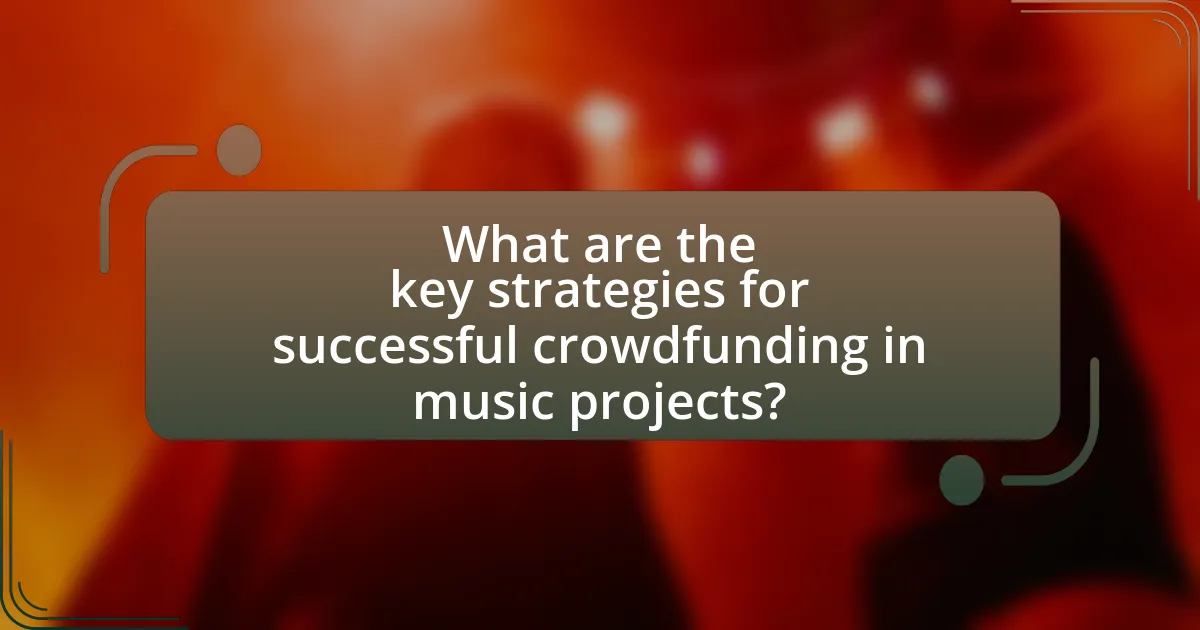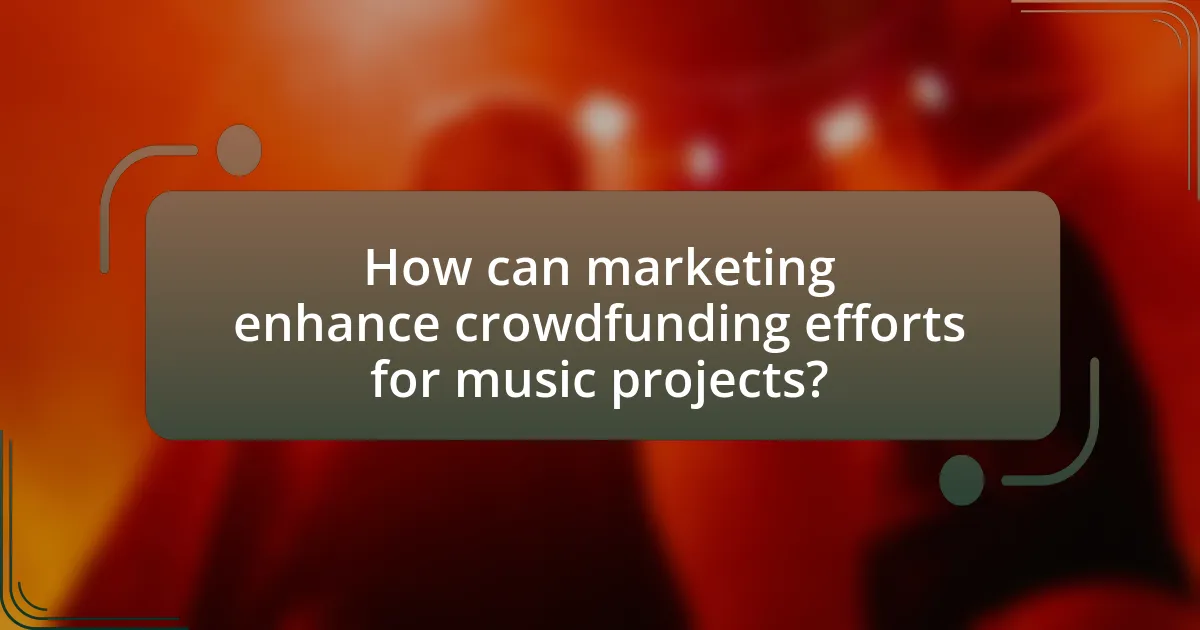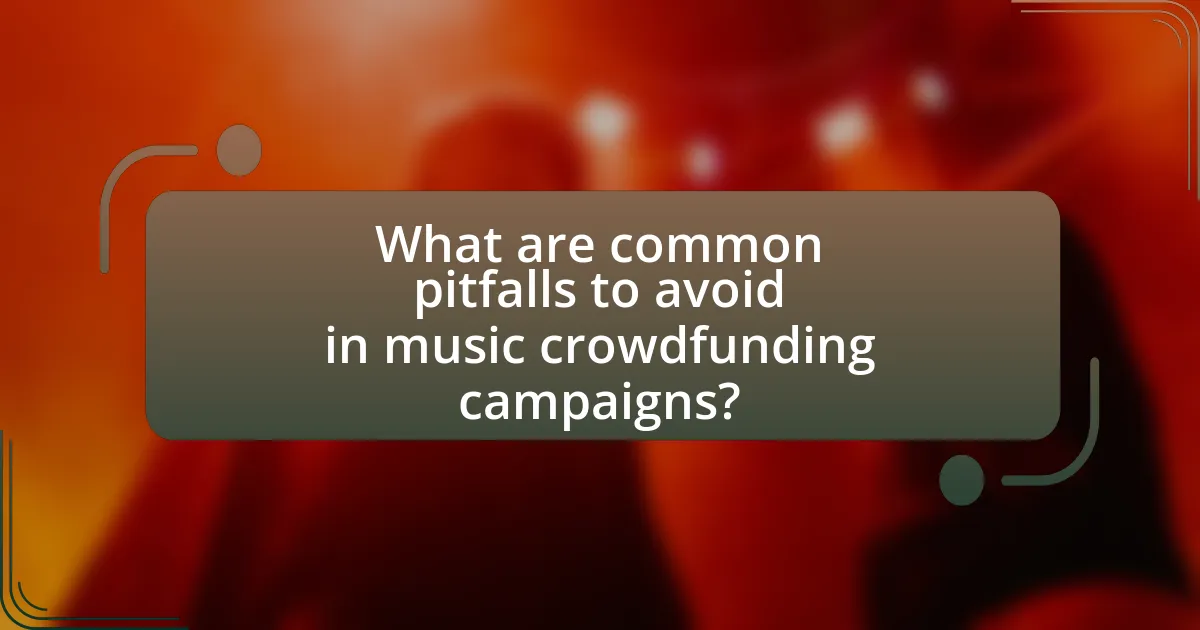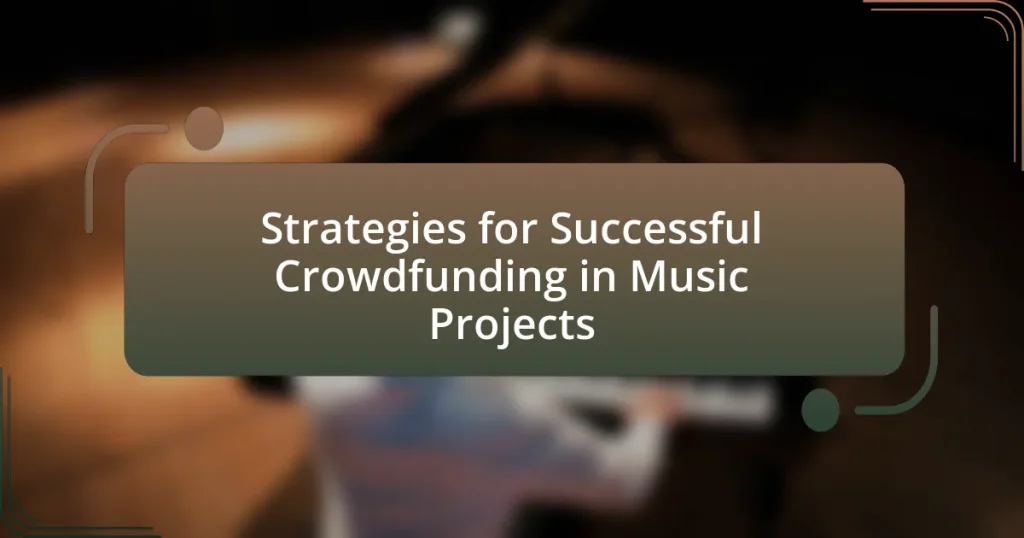The article focuses on strategies for successful crowdfunding in music projects, emphasizing the importance of building a strong community, offering compelling rewards, and creating engaging promotional content. It outlines effective planning techniques, such as setting clear goals and identifying target audiences, while highlighting essential elements of a successful crowdfunding plan. The role of audience engagement, the impact of realistic funding goals, and the significance of marketing strategies are also discussed. Additionally, the article addresses common pitfalls to avoid, best practices for post-campaign success, and methods for maintaining relationships with backers after the campaign concludes.

What are the key strategies for successful crowdfunding in music projects?
Key strategies for successful crowdfunding in music projects include building a strong community, offering compelling rewards, and creating engaging promotional content. Building a strong community involves actively engaging with fans and potential backers through social media and live events, which fosters loyalty and increases the likelihood of support. Offering compelling rewards, such as exclusive merchandise or experiences, incentivizes contributions and makes backers feel valued. Creating engaging promotional content, including high-quality videos and storytelling, captures attention and effectively communicates the project’s vision. These strategies are supported by successful campaigns on platforms like Kickstarter and Indiegogo, where projects that effectively engage their audience and offer attractive rewards tend to exceed funding goals.
How can artists effectively plan their crowdfunding campaigns?
Artists can effectively plan their crowdfunding campaigns by setting clear goals, identifying their target audience, and creating compelling rewards. Clear goals help artists define the amount of funding needed and the purpose of the campaign, which can increase transparency and trust among potential backers. Identifying the target audience allows artists to tailor their messaging and outreach strategies, ensuring that they engage individuals who are most likely to support their project. Compelling rewards incentivize contributions, as they provide backers with tangible benefits for their support, which can range from exclusive content to personalized experiences. Research indicates that campaigns with well-defined goals and attractive rewards tend to achieve higher funding success rates, as evidenced by a study from the University of Pennsylvania, which found that campaigns with specific funding targets raised 20% more than those without.
What are the essential elements of a successful crowdfunding plan?
A successful crowdfunding plan includes a clear project description, a defined target audience, a realistic funding goal, a compelling marketing strategy, and engaging rewards for backers. The project description should articulate the vision and purpose, while the target audience helps tailor the outreach efforts. Setting a realistic funding goal ensures that the project is achievable, and a well-thought-out marketing strategy, including social media and email campaigns, maximizes visibility. Engaging rewards incentivize contributions, as evidenced by successful campaigns that often offer unique experiences or products to backers.
How does setting realistic funding goals impact campaign success?
Setting realistic funding goals significantly enhances campaign success by aligning expectations with achievable outcomes. When campaigners establish attainable financial targets, they increase the likelihood of reaching or exceeding those goals, which can boost backer confidence and engagement. Research indicates that campaigns with realistic funding goals are 20% more likely to succeed compared to those with overly ambitious targets, as backers are more inclined to support projects they perceive as feasible. This alignment fosters a positive feedback loop, where initial funding milestones encourage further contributions, ultimately leading to greater overall success in crowdfunding efforts for music projects.
What role does audience engagement play in crowdfunding success?
Audience engagement is crucial for crowdfunding success as it directly influences funding levels and project visibility. Engaged audiences are more likely to contribute financially, share the campaign with their networks, and provide valuable feedback, which can enhance the project’s appeal. Research indicates that campaigns with higher engagement rates, such as comments and shares, tend to exceed their funding goals by significant margins, often achieving 20-30% more than those with lower engagement. This correlation underscores the importance of fostering a strong connection with potential backers to drive both financial support and community involvement.
How can artists build a loyal fanbase before launching a campaign?
Artists can build a loyal fanbase before launching a campaign by engaging with their audience through consistent content creation and interaction on social media platforms. By regularly sharing behind-the-scenes content, personal stories, and updates about their music, artists can foster a sense of community and connection with their fans. Research indicates that artists who actively engage with their audience can increase fan loyalty; for instance, a study by the University of Southern California found that artists who interact with fans on social media see a 30% increase in fan retention rates. This consistent engagement not only keeps fans informed but also makes them feel valued, ultimately leading to a stronger, more dedicated fanbase ready to support future campaigns.
What strategies can be used to maintain engagement during the campaign?
To maintain engagement during a crowdfunding campaign for music projects, creators should utilize regular updates, interactive content, and community involvement. Regular updates keep backers informed about progress and milestones, fostering a sense of connection and investment in the project. Interactive content, such as polls or Q&A sessions, encourages participation and feedback, making backers feel valued. Community involvement, through social media groups or live events, strengthens relationships and builds a supportive network. Research indicates that campaigns with frequent updates see a 50% higher likelihood of reaching their funding goals, demonstrating the effectiveness of these strategies in maintaining engagement.
What types of rewards are most effective in music crowdfunding campaigns?
The most effective types of rewards in music crowdfunding campaigns include exclusive content, personalized experiences, and tangible merchandise. Exclusive content, such as early access to music or behind-the-scenes videos, creates a sense of urgency and value for backers. Personalized experiences, like private concerts or meet-and-greet opportunities, foster a deeper connection between artists and supporters. Tangible merchandise, including vinyl records, signed posters, or branded apparel, appeals to fans’ desire for physical memorabilia. Research indicates that campaigns offering a mix of these reward types tend to achieve higher funding success rates, as they cater to diverse backer motivations and enhance perceived value.
How do different reward tiers influence backer motivation?
Different reward tiers significantly influence backer motivation by providing varying levels of engagement and perceived value. Research indicates that backers are more likely to contribute when they feel that their investment corresponds to tangible rewards, which can range from digital downloads to exclusive experiences. For instance, a study published in the Journal of Business Research found that projects with multiple reward tiers attract more backers, as they cater to diverse financial capabilities and interests, thus enhancing the overall appeal of the campaign. Additionally, higher-tier rewards often create a sense of exclusivity and urgency, motivating backers to pledge more to secure unique benefits.
What unique rewards can artists offer to stand out?
Artists can offer exclusive experiences, such as private concerts or personalized merchandise, to stand out in crowdfunding campaigns. These unique rewards create a deeper connection with fans and enhance their investment in the artist’s journey. For instance, a study by the University of Southern California found that personalized rewards significantly increase backer engagement and funding success in creative projects. By providing tangible, memorable experiences, artists differentiate themselves in a crowded market, fostering loyalty and encouraging higher contributions.

How can marketing enhance crowdfunding efforts for music projects?
Marketing can significantly enhance crowdfunding efforts for music projects by increasing visibility and engagement with potential backers. Effective marketing strategies, such as leveraging social media platforms, email campaigns, and targeted advertising, can create buzz around the project, attracting a larger audience. For instance, a study by the University of California found that campaigns with strong social media presence raised 126% more funds than those without. Additionally, storytelling through marketing can emotionally connect with supporters, making them more likely to contribute. This combination of visibility and emotional engagement leads to higher funding success rates for music projects.
What marketing channels are most effective for promoting crowdfunding campaigns?
Social media platforms are the most effective marketing channels for promoting crowdfunding campaigns. These platforms, including Facebook, Instagram, and Twitter, allow creators to reach a broad audience, engage with potential backers, and share updates in real-time. According to a study by Indiegogo, campaigns that actively use social media can raise up to 50% more funds than those that do not. Additionally, email marketing is also highly effective, as it enables direct communication with supporters and can lead to higher conversion rates. Research indicates that personalized email outreach can increase engagement by 29%.
How can social media be leveraged to reach potential backers?
Social media can be leveraged to reach potential backers by creating targeted campaigns that engage specific audiences. Utilizing platforms like Facebook, Instagram, and Twitter allows musicians to share their projects, showcase behind-the-scenes content, and interact directly with fans. For instance, a study by the Pew Research Center indicates that 69% of adults in the U.S. use social media, providing a vast audience for outreach. Additionally, using targeted ads can increase visibility among users who have shown interest in similar music genres or crowdfunding campaigns, enhancing the likelihood of attracting backers. Engaging content, such as videos and live streams, can also foster community and encourage sharing, further expanding reach.
What role do email newsletters play in campaign promotion?
Email newsletters serve a crucial role in campaign promotion by facilitating direct communication with an audience, thereby enhancing engagement and driving support for crowdfunding initiatives in music projects. They allow creators to share updates, exclusive content, and calls to action, which can significantly increase the likelihood of contributions. According to a study by the Direct Marketing Association, email marketing has an average return on investment of $42 for every dollar spent, underscoring its effectiveness in reaching and converting potential backers. This direct line to supporters not only fosters a sense of community but also keeps the campaign top-of-mind, ultimately contributing to its success.
How can storytelling improve the appeal of a crowdfunding campaign?
Storytelling can significantly enhance the appeal of a crowdfunding campaign by creating an emotional connection with potential backers. This connection fosters empathy and engagement, making individuals more likely to support the project. Research indicates that campaigns that incorporate personal narratives and relatable stories can increase funding success rates by up to 30%. For example, a study published in the Journal of Business Research found that campaigns with compelling narratives attracted more attention and funding compared to those that presented only facts and figures. By effectively communicating the project’s purpose and the impact of contributions through storytelling, creators can motivate supporters to contribute, thereby improving the overall success of the crowdfunding effort.
What elements of storytelling resonate most with music fans?
Music fans resonate most with storytelling elements that evoke emotional connection, authenticity, and relatability. These elements include personal narratives that reflect the artist’s journey, struggles, and triumphs, which create a sense of intimacy and shared experience. For instance, songs that tell stories of love, loss, or social issues often engage listeners on a deeper level, as they can see their own experiences reflected in the music. Research indicates that emotional storytelling in music can enhance listener engagement and loyalty, making it a powerful tool for artists seeking to connect with their audience and successfully fund their projects.
How can artists share their journey to connect with backers?
Artists can share their journey to connect with backers by utilizing social media platforms, creating engaging content that showcases their creative process, and providing regular updates on their projects. By sharing behind-the-scenes footage, personal stories, and milestones, artists foster a sense of community and transparency, which can enhance emotional investment from backers. Research indicates that campaigns with regular updates are 50% more likely to reach their funding goals, demonstrating the effectiveness of consistent communication in building relationships with supporters.

What are common pitfalls to avoid in music crowdfunding campaigns?
Common pitfalls to avoid in music crowdfunding campaigns include setting unrealistic funding goals, neglecting to engage with backers, and failing to create a compelling campaign narrative. Setting unrealistic funding goals can lead to campaign failure, as evidenced by a study showing that campaigns with achievable targets are 20% more likely to succeed. Neglecting to engage with backers can diminish trust and interest; research indicates that campaigns with regular updates and communication see a 30% increase in funding. Lastly, a lack of a compelling narrative can fail to capture potential backers’ attention, as campaigns that tell a story typically raise 50% more than those that do not.
What mistakes do artists often make when setting up their campaigns?
Artists often make the mistake of not clearly defining their target audience when setting up their campaigns. This lack of focus can lead to ineffective messaging and poor engagement, ultimately resulting in lower funding. Research indicates that campaigns with a well-defined audience are 50% more likely to reach their funding goals, as they can tailor their outreach and communication strategies effectively. Additionally, artists frequently underestimate the importance of setting realistic funding goals, which can create disillusionment among backers if the campaign fails to meet expectations.
How can lack of preparation lead to campaign failure?
Lack of preparation can lead to campaign failure by resulting in insufficient audience engagement and unclear messaging. When a crowdfunding campaign for a music project is not well-prepared, it often fails to identify and connect with its target audience, leading to low visibility and support. For instance, a study by Indiegogo found that campaigns with a clear strategy and defined goals raised 50% more funds than those without. Additionally, inadequate preparation can lead to poor budgeting and unrealistic funding goals, which can deter potential backers. Therefore, thorough preparation is essential for establishing a compelling narrative and ensuring effective outreach, ultimately influencing the success of the campaign.
What are the consequences of underestimating marketing efforts?
Underestimating marketing efforts can lead to insufficient funding and project failure in music crowdfunding campaigns. When artists fail to allocate adequate resources to marketing, they often miss reaching their target audience, resulting in lower visibility and engagement. According to a study by Kickstarter, projects that actively engage in marketing strategies are 50% more likely to reach their funding goals compared to those that do not prioritize marketing. This demonstrates that neglecting marketing can severely limit a project’s potential for success.
How can artists effectively manage their crowdfunding campaigns?
Artists can effectively manage their crowdfunding campaigns by setting clear goals, engaging their audience, and maintaining consistent communication. Clear goals help define the funding target and project timeline, which can motivate backers. Engaging the audience through social media and updates fosters a sense of community and investment in the project. Consistent communication, including regular updates on progress and challenges, keeps backers informed and encourages continued support. Research indicates that campaigns with regular updates see a 50% higher success rate, highlighting the importance of these strategies in achieving crowdfunding success.
What tools can help track progress and manage backer communication?
Tools that can help track progress and manage backer communication include project management software like Trello, communication platforms such as Slack, and crowdfunding-specific tools like Kickstarter’s built-in updates feature. Trello allows users to create boards for tracking project milestones, while Slack facilitates real-time communication with backers. Kickstarter’s updates feature enables creators to send messages directly to backers, keeping them informed about project developments. These tools enhance organization and foster engagement, which is crucial for maintaining backer support throughout the crowdfunding process.
How should artists handle challenges that arise during the campaign?
Artists should proactively address challenges during a crowdfunding campaign by maintaining clear communication with their supporters and adapting their strategies as needed. Effective communication helps to build trust and keeps backers informed about any issues, while adaptability allows artists to pivot their approach based on feedback or unforeseen circumstances. For instance, if funding slows down, artists can engage their audience through updates, additional incentives, or targeted marketing efforts to reignite interest. Research indicates that campaigns with regular updates see a 50% higher success rate, demonstrating the importance of transparency and responsiveness in overcoming obstacles.
What are the best practices for post-campaign success?
The best practices for post-campaign success in music crowdfunding include analyzing campaign performance, engaging with backers, and fulfilling rewards promptly. Analyzing performance involves reviewing metrics such as funding sources and backer demographics to understand what worked and what didn’t, which can inform future campaigns. Engaging with backers through updates and personalized communication fosters community and encourages ongoing support. Fulfilling rewards promptly is crucial, as timely delivery enhances trust and satisfaction among backers, leading to potential future support. According to a study by Indiegogo, campaigns that maintain communication with backers post-campaign see a 30% increase in repeat funding.
How can artists maintain relationships with backers after the campaign ends?
Artists can maintain relationships with backers after the campaign ends by providing regular updates and engaging communication. Consistent updates about project progress, milestones, and future plans keep backers informed and invested in the artist’s journey. Engaging communication can include personalized thank-you messages, exclusive content, or invitations to events, which fosters a sense of community and belonging among backers. Research indicates that maintaining ongoing engagement can lead to higher rates of repeat support, as backers feel valued and connected to the artist’s work.
What steps should be taken to fulfill rewards and ensure satisfaction?
To fulfill rewards and ensure satisfaction in crowdfunding for music projects, project creators should implement a structured plan that includes clear communication, timely delivery, and quality assurance. First, creators must establish transparent timelines for reward fulfillment, ensuring backers are informed about when to expect their rewards. This can be supported by regular updates on project progress, which fosters trust and engagement.
Next, creators should prioritize the quality of the rewards offered, ensuring they meet or exceed the expectations set during the crowdfunding campaign. This can involve sourcing materials from reputable suppliers or collaborating with skilled professionals to enhance the final product.
Additionally, creators should have a responsive customer service approach to address any inquiries or concerns from backers promptly. This responsiveness can significantly enhance backer satisfaction and loyalty.
Finally, gathering feedback from backers after fulfillment can provide valuable insights for future projects, allowing creators to refine their processes and improve overall satisfaction. Implementing these steps can lead to a successful crowdfunding experience and foster a positive relationship with supporters.
